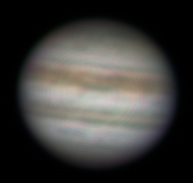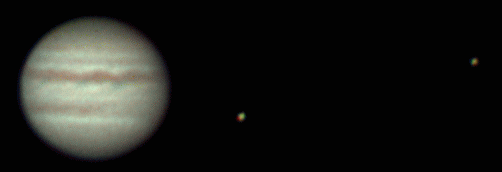|
Jupiter |
(Home) |
Our fifth planet is a monster, more than twice as massive as all the other planets put together at 318 times the earth's mass. It is 89000 miles through at the equator and spins once around in 10 hours. This makes the speed of the equator almost 28000 miles an hour. It is 5.2 times farther out from the Sun than is Earth.
![]()
 First
try with the 4X Barlow giving f/40 on the 12" LX200 and ST-8E. Still no red spot! (I going to have to plan
better...) Also, seeing was not good this night. LRGB image with ten
0.2 second luminance binned 2x2, and 3 each for the RGB's at 0.2 seconds also
binned 2x2.
First
try with the 4X Barlow giving f/40 on the 12" LX200 and ST-8E. Still no red spot! (I going to have to plan
better...) Also, seeing was not good this night. LRGB image with ten
0.2 second luminance binned 2x2, and 3 each for the RGB's at 0.2 seconds also
binned 2x2.
Processed with a high pass filter.
Taken at the Mistletoe site outside Monmouth Oregon on November 16, 2000.
![]()
The movie below was taken over an hour and a half. Unfortunately, the Great Red Spot had just set to the east (on the right). The good news was that a couple of the moons were near by (Io moving to the right, Europa moving to the left). Note that the moons show as multi-color spots, due to their motion between filter changes. Jupiter was just a month before opposition, so was quite large and bright.

The movie contains 9 color frames with 10 minutes between frame. Each frame contains one each red, green, and blue exposure of 150ms, 180ms, and 450ms respectively. Also my system needs a different focus for each of the color filters. By the time an hour and a half had gone by, I was exhausted.
The equipment was the 12" LX200 at f/10 through the 616 filter wheel to the 416XT CCD. I used PictorView SW to get SCSI download performance. Good performance was desired so that the separate RGB shots would not show skew due to Jupiter's rotation. Even so, the moons show some color skew as mentioned above. The images were taken Sept 10, 1999 at the Oregon Star Party.
Image processing included:
![]()
Previous try, taken Sept 27, 1997.
Visually it's like looking into a headlight with the 12" telescope. I wasn't sure I could capture it at all on a CCD.
A 20 millisecond
exposure taken with the 416 at f/10 at Juniper Sky. (Focus
could have been better, but I rushed it).
The Picture below was from the same raw data, but has been
rotated and enhanced away from the planet to bring out the moons.
According to TheSky when set to 9/27/97 at 23:39 we are seeing
from right to left Io, Europa, and Ganymede. Callisto is outside
the field of view to the right. The order listed is the order out
from the planet.
Of course, the above moons are what sent Galileo to jail..., they
obviously didn't go around the Earth.
![]()